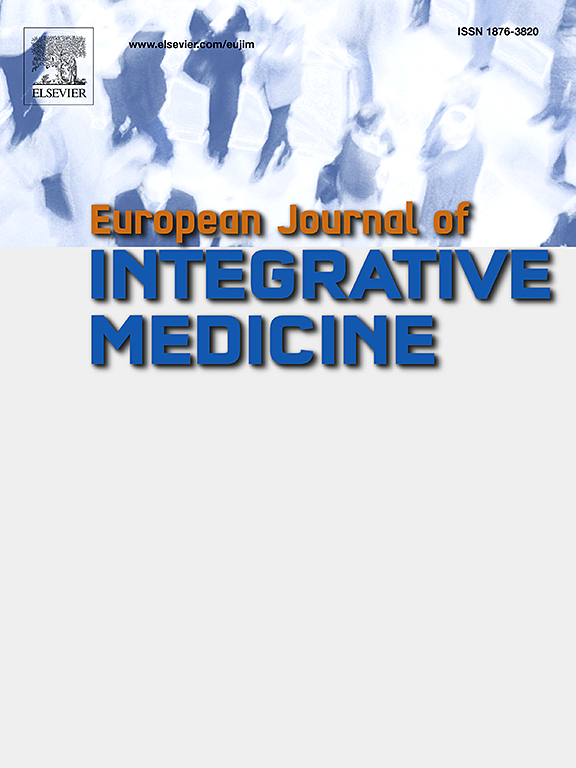复方血栓通胶囊抗视网膜静脉闭塞的证据构建:荟萃分析和网络药理学
IF 1.7
4区 医学
Q3 INTEGRATIVE & COMPLEMENTARY MEDICINE
引用次数: 0
摘要
视网膜静脉闭塞(RVO)是第二常见的视网膜血管疾病。在中国,复房血栓通胶囊(FXC)是一种常用的治疗RVO的复方中药。本文旨在阐述FXC治疗RVO的疗效和药理机制。方法检索8个数据库至2024年9月17日,收集符合标准的文献。两位研究者独立评估了综述的质量,并使用Stata 16.0对每个指标进行meta分析。然后,通过网络药理学方法探讨FXC治疗RVO的潜在机制。结果meta分析纳入18项随机对照试验(RCTs),共1574例患者。结果表明,与常规/中药注射剂治疗相比,FXC单用或联用可提高临床疗效,提高最佳矫正视力(BCVA),降低中央黄斑厚度(CMT),改善血液流变学,改善血流动力学指标,改善眼底形态,降低中医评分,且不良反应发生率较低。网络药理学发现其核心成分有槲皮素、β-谷甾醇、刺长柄花素、木犀草素、丹参酮IIA等,核心靶点有tgf - β1、PKC、JNK、ERK1/2、VEGF、MCP-1、VACM-1、IL-6、TNF-α、Akt等。这些靶点和通路中有几个与RVO有关,药理机制主要与糖尿病并发症中的AGE-RAGE信号通路有关。结论fxc治疗RVO临床有效、安全。它通过多组分、多靶点和多通路网络协同治疗RVO。糖尿病并发症中的AGE-RAGE信号通路可能是FXC改善RVO炎症和血栓形成的关键通路之一。还需要进一步的基础实验和高质量的随机对照试验来丰富FXC治疗RVO的证据链。本文章由计算机程序翻译,如有差异,请以英文原文为准。

Evidence construction of Fufang Xueshuantong Capsule against retinal vein occlusion: A meta-analysis and network pharmacology
Introduction
Retinal vein occlusion (RVO) is the second most prevalent retinal vascular disease. In China, Fufang Xueshuantong Capsule (FXC) is a common compound Chinese medicine used to treat RVO. This review aims to illustrate the therapeutic efficacy and pharmacological mechanisms of FXC for RVO.
Methods
Eight databases were searched until 17 September 2024 to collect literature meeting the criteria. Two investigators independently assessed the quality of the review and used Stata 16.0 to meta-analyse each metric. Then, network pharmacology was performed to explore the underlying mechanisms of FXC in the treatment of RVO.
Results
A meta-analysis included 18 randomized control trials (RCTs) with 1574 patients. Our results indicated that compared to conventional/traditional Chinese medicine injection (TCM) therapies, FXC alone or in combination can enhance clinical effectiveness, raise best-corrected visual acuity (BCVA), reduce central macular thickness (CMT), improve hemorheology, ameliorate hemodynamic indices, enhance fundus morphology, and decrease TCM scores with a lower adverse reaction incident. Network pharmacology revealed core components included quercetin, β-sitosterol, formononetin, luteolin, tanshinone IIA, etc., and the core targets such as TGFβ1, PKC, JNK, ERK1/2, VEGF, MCP-1, VACM-1, IL-6, TNF-α, and Akt. Several of these targets and pathways are related to RVO, and the pharmacological mechanism is mainly related to the AGE-RAGE signaling pathway in diabetic complications.
Conclusion
FXC is clinically effective and safe for treating RVO. It synergistically treats RVO through a multi-component, multi-target, and multi-pathway network. The AGE-RAGE signaling pathway in diabetic complications may be one of the key pathways of FXC to ameliorate inflammation and thrombosis in RVO. Further basic experiments and high-quality RCTs are still needed to enrich the evidence chain for FXC in treating RVO.
求助全文
通过发布文献求助,成功后即可免费获取论文全文。
去求助
来源期刊

European Journal of Integrative Medicine
INTEGRATIVE & COMPLEMENTARY MEDICINE-
CiteScore
4.70
自引率
4.00%
发文量
102
审稿时长
33 days
期刊介绍:
The European Journal of Integrative Medicine (EuJIM) considers manuscripts from a wide range of complementary and integrative health care disciplines, with a particular focus on whole systems approaches, public health, self management and traditional medical systems. The journal strives to connect conventional medicine and evidence based complementary medicine. We encourage submissions reporting research with relevance for integrative clinical practice and interprofessional education.
EuJIM aims to be of interest to both conventional and integrative audiences, including healthcare practitioners, researchers, health care organisations, educationalists, and all those who seek objective and critical information on integrative medicine. To achieve this aim EuJIM provides an innovative international and interdisciplinary platform linking researchers and clinicians.
The journal focuses primarily on original research articles including systematic reviews, randomized controlled trials, other clinical studies, qualitative, observational and epidemiological studies. In addition we welcome short reviews, opinion articles and contributions relating to health services and policy, health economics and psychology.
 求助内容:
求助内容: 应助结果提醒方式:
应助结果提醒方式:


